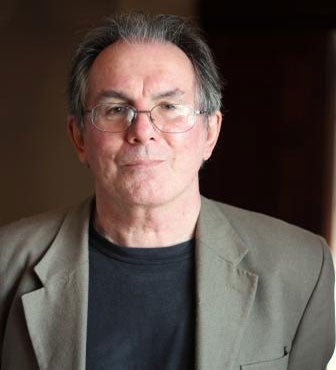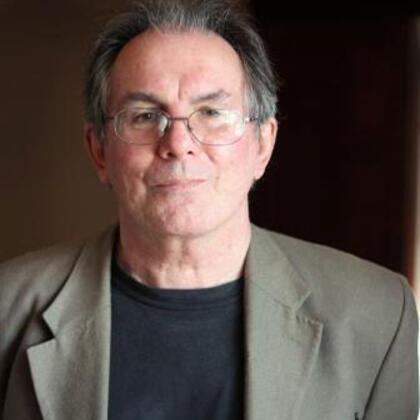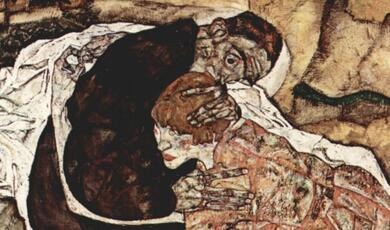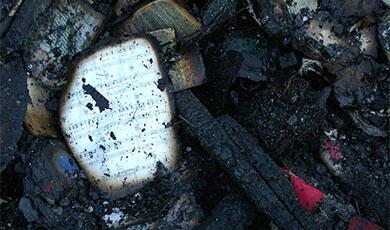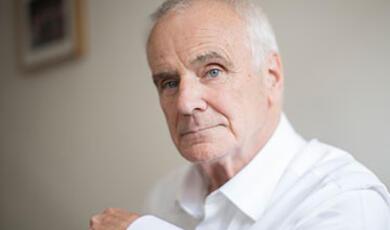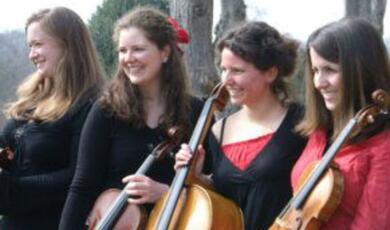Film Music: Hitchcock's Psycho
Share
- Details
- Transcript
- Audio
- Downloads
- Extra Reading
Alfred Hitchcock's 1960 masterpiece is inextricably tied up with its difficult, modernist score written by Bernard Herrmann. For example, it is almost impossible to imagine the famous 'shower scene' without Herrmann's contribution even though the scene was initially imagined by Hitchcock to be without music. In this and other scenes, there are interesting ways in which the music poses questions about the film's meaning: questions that may even go beyond Hitchcock's famously all-encompassing intentions.
Download Transcript
Professor Roger Parker
At the end of the last lecture, my first in this series about film music, we were in the early 1930s, in the company of an exuberantly screaming Fay Wray as she heralded the appearance of her exceptionally tall and exceptionally dark leading man. The musical accompaniment was an equally exuberant symphonic score by Max Steiner, one of the great composers of the period. As I said then, there are plenty of ways in whichKing Kong now looks dated in both visual and musical terms; but there are equally striking ways in which Steiner's score marks the appearance of a set of codes about how music was to interact with the visual element of films: codes that to some extent remain with us to this very day.
One of the most obvious of these codes was in Steiner's use of what we in the music trade call leitmotifs: prominent themes that become attached to aspects of the unfolding drama and that then recur, sometimes with significant development, when those aspects recur in the narrative. And so, in King Kong, the gentle string theme that accompanied the heroine's onboard love scene comes back, played by the full orchestra and horribly distorted, as the camera settles on her, struggling to escape becoming the next sacrificial victim to the monster of Skull Island. This was, of course, an old trick borrowed (as were so many film-music devices) from opera: the obvious point of reference is the leitmotif system elaborated at huge length in Wagner's operas, but the technique goes back a good deal further. And of course we can hear it in a certain kind of film today: in particular ones that strive for an "epic" quality. The most obvious recent example is Peter Jackson's Lord of the Rings trilogy, in which Howard Shore's musical score includes leitmotifs for a host of people and places, in the process helping us (perhaps too eagerly on some occasions) to identify with and emote about the principal strands of the story.
Another of Steiner's codes, though, is more exclusive to film music. Films are necessarily full of cuts, of sudden transitions between one camera shot and another. There are all sorts of visual ways of minimizing the inevitable sense of disorientation that such cuts will engender in the viewer, and I'm sure you can think of several: the screen goes wavy for trips back and forward in time; the picture reduces in size or goes gradually darker to mark a transition; or, of course, the camera simply follows or precedes the character in a tracking shot, obviating the need for any "cut". What is less often noticed, though, is the way in which the musical score will habitually smooth over this tendency towards fragmentation. Film-music composers very soon realised that having music continue across a prominent cut in the visual narrative served to bind the whole experience together, making viewers less aware of the sudden change and thus less aware of the film world's essential artificiality. Film theorists refer to this technique of binding together cuts in the film as "suture", and the word's medical associations (of the stitching that binds together a wound) are perhaps useful. The "suture" devices, after all, bind us into the filmic narrative, making whole what could otherwise be thought of as wounding or distressing or alienating.
Steiner's score for King Kong was written in the early 1930s, very close to the time of various technological advances that allowed film music to become, as it had been in the silent movie era, an enormously important part of the film experience. Crucial among these developments, as I mentioned last time, was the discovery of how to record the sound track and the music track separately from the visual material. There was no more need to hang microphones on trees or hide them in vases of flowers; if the shot was at all complex, the sound could be recorded later. And this was what almost always happened, in particular to film music. Although there are exceptions, the musical score to a film tends to be added at a comparatively late date, certainly once its narrative is fixed, and usually once its sequence of scenes has been decided upon, shot and edited. In that sense, we could regard film music as a kind of commentary on what has already been created. We should not, though, take this belatedness to mean lack of importance. Most films are created with the full expectation that music will accompany many of its scenes-theexpectation for music is, in other words, typically embedded in the basic structure of the film from its first inception; it is only the realisation that comes later.
It was partly because of these technological advances that the period immediately after King Kong, which was released in 1933, proved in many ways to be a golden age for Hollywood film, and in particular for the kind of symphonic score pioneered by Steiner. The twenty years that followed were the era of the great Hollywood studios (MGM, Warner Brothers, etc.), organizations that could command elaborate musical resources and that caused a general migration of musicians to the West Coast, particularly in the wake of the severe downturn in live music on the East Coast caused by the Great Depression. Steiner himself continued his activity, making some of the grandest and most innovative scores of the period, not least the epic to end all epics that was Gone with the Wind(1939). During this period, many of the most prominent film composers came from the same background as Steiner-they were émigrés from central Europe; and so it is no surprise that the dominant idiom was very much of that place, with the late-Romantic idiom of post-Wagnerian composers, early Richard Strauss the most successful and most often-imitated. Indeed some of these musicians had even started life in Europe as classical composers, and had been obliged to ply their trade in Hollywood merely through force of political and economic circumstance. One of the most successful was Erich Wolfgang Korngold, who had a respectable career as an orchestral and operatic composer, praised by Mahler and Strauss, before moving to Hollywood in 1934 and completing such seminal scores as The Adventures of Robin Hood (1938, starring Errol Flynn). After the war Korngold returned to concert composition, although works such as the Violin Concerto (1947) were, at least for modernist tastes of the time, judged to contain rather more of the korn and rather less of the gold.
This tendency for Golden-Age Hollywood scores to sound belated stylistically, as if their music could have been written by classic composers of decades past, was surely an important part of their success, and also displays-not for the first or last time-that film has always had a complex relationship with elite culture, and that unashamedly modernist music made little headway, at least so far as Hollywood was concerned. However, there was a moment in the late 1950s and early 1960s when it seemed as though this might change: when, for a brief time, some genuinely mass-audience films began to experiment with alternative narrative conventions and, at more-or-less the same time, also experiment with a different kind of musical underpinning, one a lot nearer to the type of product that could then be heard in the concert hall. A prime example of that trend-indeed, probably its most famous representative-is the film I want to concentrate on this week. The year was 1960, the director was Alfred Hitchcock, and the film was, of course,Psycho.
There are probably more books written about Alfred Hitchcock than about any other film maker; my own shelves groan with them, from the frankly popular to the severely academic, and I will have to resist the temptation to get caught up in the latter's ruminations, to which I am sometimes professionally drawn. Why this interpretative industry? One modern commentator, the formidable Slovenian cultural critic, philosopher, political pundit and so much more, Slavoj Zizek, has discussed this phenomenon at some length. He suggests that there is something about Hitchcock's best films that seems to appeal simultaneously to interpreters of otherwise very different persuasions. On one level, the films can be taken as simple, realist narratives-as part of the Hollywood mainstream. On another level they can be seen as contributing to a more austere modernist tradition: they are often difficult, are clearly driven by an iron, controlling will (the so-called auteur), and often obsessed with Freudian and other subtexts. And on yet another level Hitchcock has been embraced by and claimed for the postmodernists: as someone who is playful about high cultural pretentions and is liable constantly to undercut his most serious artistic effects. An iconic example of all this might be Hitchcock's habit of making a cameo appearance in each of his films, a gesture that is simultaneously comic and sinister and controlling. No wonder academics write about him obsessively; Hitchcock's peculiar brand of self-consciousness, as Zizek says, tends to encourage us to think that everything in his films must have meaning.
This is some achievement, one might think, for a person born in the London of Queen Victoria, in Leytonstone in 1899, the son of a greengrocer. He died in Bel Air, Los Angeles in 1980, and so had come a considerable distance by any standards. Hitchcock's early career, up to 1939, was in England, and his first films were made in the silent era; but by the time of his move to the US he already had a distinctive, unsettling voice, one that became more pronounced at (one could say became enabled by) the peak of his popularity in the 1950s and early 1960s. And it is immediately striking that many of his films involve music in some kind of exceptional way: that, if you will, music often contributed to the strangeness and originality of his creative personality. In The Man Who Knew Too Much (first issued in 1934, then remade, much more famously, in 1956) the climax of the film involves an assassination that will take place at a symphony concert, during an orchestral climax; Hitchcock opined that viewers ideally needed to understand musical notation in order to grasp the full tension of the denouement. In The Birds (1963), on the other hand, there is no music except that produced by the film's characters, in particular by the crazed almost-music of the avian protagonists, which is organized and "orchestrated" with enormous care and telling effect. In between these two films came Psycho, and in all three cases the sound was masterminded by one of the figureheads of what we might call film-music's avant garde, the redoubtable Bernard Herrmann.
Herrmann was born in New York City in 1911, and although he was not far from "Golden-Age" composers such as Steiner and Korngold in terms of years, his musical upbringing was in one way decisively different. While, as mentioned, their basic musical heritage came from the Austro-German symphonic tradition, his was more eclectic, particularly after a period of study with Percy Grainger. Herrmann favoured the "alternative" traditions of Russia, France and England (he was a great lover of Delius, for example) and constantly tended towards the experimental and innovative. Partly as a consequence of this, he distanced himself somewhat from the practices of mainstream Hollywood, insisting on taking more time to produce his scores, and (unusually for the time) on orchestrating them himself: this last was a critical step, in that-as we shall see-it allowed him to make orchestration a critical and highly individual part of his music's atmosphere. Small wonder, then, that Hermann became associated with those on the experimental wing of Hollywood production: first with Orson Welles, for whom he wrote the scores of both Citizen Kane in 1940 andThe Magnificent Ambersons in 1942; and then, most famously, with Hitchcock from the mid 50s to 60s.
Let's dive into Psycho at its beginning. As mentioned last week, the credits of a film are often a place in which the director and the composer can lay out their stalls; and in this case a sharply edged stall it is indeed. We talked earlier about film "cuts", the medium's inevitable popensity for fragmentation and jaggedness, and how this is often smoothed over by music. But here at the start of Psycho, both words and music seem instead to conspire to emphasise this potential. I'll continue the example into the first moments of the narrative, just so you can hear what does and what doesn't bind together this crucial first juncture in the film.
PLAY PSYCHO Start of Chapter 1 (0:00) to 2:20
You'll have noticed immediately several ways in which there are connections between the style of the credits and that of the music that underpins them (or, rather, one might immediately say, drives them forward). There's the obvious sense in which Hitchcock's decision to make this film in black and white (colour was freely available by 1960) is matched by Herrmann's decision to use only strings: in both cases, there is what we might call an immediate (in both the visual and musical sense of the word) chromatic austerity. The austerity is also evident in the sudden, jerky movements and fragmentation of the names as they appear, and-not least-in the fragmentary nature of the music: its Bartokian surface, so very unlike the late-Romantic idiom of "Golden-Age" composers, involves a succession of short, disjunctive ideas, mostly them highly dissonant and all of driving intensity. But it is not just the musical idiom that matches the visual sequence. Imagine for a moment what physical actions the entire string ensemble take to create those driving down-bows at the start, the rapid "stabbing" gestures they must make.
There are slight elements of both visual and musical "suture" into the main narrative: the announcement of the town and the date and time mimic the credits in their jerky appearance, and the low bass note that finishes the credits sequence becomes the pedal of the mysterious chords that accompany the opening panning shot of Phoenix. But on the whole, and as in much of Hitchcock's later work, the film proper begins with a deliberate descent into the ordinary: something in itself quite shocking after those melodramatic and highly changed credits. By a deliberate "trick" shot we seem to follow the camera, in a voyeuristic manner that will characterise much of the film, into a hotel bedroom. I said "descent", and this is again what literally happens both to the camera and the music; it is almost as though the tension of the opening is being quietly released. The scene that follows seems to be of the most banal: a clandestine encounter in a cheap hotel. Hitchcock knew just what he was doing here: his reputation was such now that he could afford to "make the audience wait" at the start of his films, both he and they knowing that the shocks to come would be all the more effective if the temperature had dropped.
I want to play this first scene to you in a moment. It's by no means one of the famous moments in the film, but it demonstrates quite clearly some of the filmic techniques that will be used in later, more celebrated moments, and also introduce us further to Herrmann's musical language. The scene introduces us to two troubled lovers, seemingly reaching the end of an affair; it is above all low key and clichéd. But notice how Hitchcock injects a sense of strangeness into the scene at the very start. Our first view of the lovers is extremely odd, for example: Marion Crane (played by Janet Leigh) is lying on the bed, but with the camera almost at her level so she is strangely distorted; and of her lover Sam's body we only see the bottom half, and on a different plane entirely. It seems, in short, as if these figures can only be seen in fragments, and the sense in which we seem to be presented with just bits of them continues through most of the scene. It is, if you want, another kind of "cutting" that takes place here, one that is exacted by the camera on the very people it captures. There are also other kinds of cuts. After that extraordinary first shot, Marion's lover speaks the first line of the film: "You never did eat your lunch, did you?" And right on cue the camera dives to a picture of the messy, uneaten lunch. Such strange, disorientating camera gestures are all part of the games played in this first scene, and mostly they are meant to unsettle, in particular to make us wonder who is holding the camera, who is looking in on these two people and for what reason? There's another contributor factor to this unease: Marion spends a great deal of the scene looking into a mirror that we don't see: again, a strange, disorientating device that will come back to haunt the narrative much later.
As you're watching the scene, though, also pay some attention to Herrmann's contribution. The scene has two passages of music, one in the middle, and one at the end. The latter clearly acts as a classic "suture" device: it starts as this scene is winding up and continues across the break into the first moments of the next scene, in order for that "cut" to be less disorientating. But the first is different. See what you make of it, but also notice how it finishes, when Marion's lover goes to the window and suddenly opens the blind: there is a rush of light, and also a rush of ambient noise from the road below: light and noise drown out the musical sounds. Again, as so often in film sound, it is as if the ambient noise of the narrative is in some sense in competition with the musical.
PLAY PSYCHO Start of Chapter 2 (1:53) to 6:33
That character in the Stetson hat, by the way, was Hitchcock: as if his presence hasn't been so obviously there throughout the first scene, he is hanging around outside the window in the second. But what does the music do? Clearly in one sense it's conventional: there in the middle and end to give structure and coherence to the scene, and also to intensify the emotional impact of what is, after all, a love scene of a kind. But, to repeat, it's a very strange love scene visually (and, not incidentally, it involves the heroine putting her clothes on rather than taking them off), and the music that accompanies it is also strange, its curiously melancholic harmonies in some sense at odds with the dialogue.
This opening scene has, as it were, unobtrusively introduced us to many of the key features of the film: the intrusive, voyeuristic camera behaviour, the play with mirrors, the strange angles on characters, etc.; for those of you who know the film's continuation well, these anticipations are spiced further by some obvious verbal foreshadowing, not least that line about how they will have to "turn[] mother's picture to the wall" while they make love. And the music plays this game too, in particular through its relationship to ambient noise, and also by colouring darkly scenes that might otherwise be thought more drab.
I need to move on to the first, and most famous climax of Psycho, but to give you an idea of how the mood and behaviour of this first scene is gradually intensified, let's look briefly at a subsequent scene. Marion, we learn, works for an attorney, and is entrusted with $40,000 in cash. Instead of depositing it, she decides to escape to a new, affluent life with her lover. The scene in which she makes this decision is another in which the play of the camera and the play of music are intricately entwined, almost like a repeat of the opening scene, but now much more obviously disturbed. The camera is constantly diving away to linger on objects (particularly the envelope stuffed with money, but also Marion's suitcase and handbag), in the process making us aware of its presence; there is again great play with a mirror in the room, which increases this sense of "looking in"; Marion again performs a reverse striptease. And this time the music takes even greater agency, seeming in a sense to represent the gradual taking shape of Marion's plan. The score is made of three distinct layers: very high, sustained violins, an almost unearthly sound; a nervous, hesitant, obsessive idea on the violas; and the usual, sinister bass. You might almost say that, in comparison with the opening scene, it represents a regression from music into something more elemental: certainly the highest and lowest sounds threaten constantly to disappear into something like noise. The music, in other words, makes clear what we can also see in the strange camera angles: that while this may be in some ways a re-composition of the first scene, the stakes are now higher, the mood darker and above all more visceral. We are heading somewhere-a somewhere that we are being warned cannot possibly be pleasant.
PLAY PSYCHO Chapter 4 (10:20) to 12:10
The ultimate destination is, of course, a nondescript room in the most famous motel in movie history, the one managed by a pleasant, shy young man called Norman Bates (played by Anthony Perkins). Marion has been forced to stop there by terrible, driving rain, curtailing her bid for Californian escape. But after a long conversation with Norman, much of which is about his obviously difficult and domineering mother, whose voice Marion has heard from Norman's house by the side of the motel, she decides that she must after all return to Phoenix, and give back the money she has stolen. With that firmly in her mind, she decides to turn in for the night; and of course, like all good Americans but also as an evident symbol of her decision to "cleanse" herself of the misdeed, she takes a shower.
One of the best-known facts about the scene which follows is that Hitchcock first imagined it entirely without music. To us now this might seem profoundly shocking, in that over the years the music of the scene has wedded itself to the action in a way that makes it impossible for us to imagine it differently. But on the other hand the trajectory we have witnessed thus far in the film, in particular the relationship that has been established between ambient sound and musical sound, might make a music-less shower scene at the least comprehensible, if not apt. Another way to say this is to remind ourselves that a music-less shower-scene would emphatically not mean a silent scene. Far from it.
But let's concentrate first on that sense, which I mentioned earlier, of the odd visual behaviour of the camera, and the way it seems to be intensifying as the film develops. In this respect, the shower scene is an obvious climax. The camera acts with even greater oddity, in particular by moving in seemingly arbitrary "cuts", almost as if jolted by another arm, and also by suddenly disorientating shots of inanimate objects (remember the lunch in the first scene, or the money or suitcase in the second; here it is the camera's fixation with the shower head, spraying water down). Sometimes in this scene, Hitchcock even breaks the famous 30 degree rule, which says a new camera angle must be at least that degree away from the previous one, in order to establish a different perspective. All these disorientating devices add to that ever-more-insistent question: who is holding the camera; who is looking?
Obviously related to this obsession with the camera's "eye" is the positive bombardment of symbolic action in this scene based around the idea of the circle, watching of otherwise. Moments before, Norman has stared through a tiny round hole in an adjoining wall to watch Marion undress (another climax, after the earlier, reverse stripteases). Then comes the bombardment. First is the toilet (for some at the time, apparently, the most shocking sight in the entire movie) down which Marion flushes evidence of her robbery; then the shower head, then the light reflected onto the tiles of the shower; then the plughole around which the water and other liquids circulate; and finally that famous lingering shot of Marion's unseeing eye, triply circled (pupil, iris, entire eye).
But there is more: in this scene of almost impossible extravagance, Hitchcock also assails us with a bombardment of sounds. The white noise background is the sound of water, which of course picks up on the driving rain that has led Marion to the Bates motel in the first place. This is first heard in the banal gurgle of the toilet flush. But then there is the swish of the shower curtain, the rustle of soap, and from then on the incessant noise of the shower. And later, the shower curtain opens again and, to pile on yet more activity, the camera angles start to go haywire, and there are screams and other swishing, thudding sounds; and at the last, the ambient noise returns to those banal gurgles at we focus on the plughole of the shower.
I've already given you too much information: too many layers on which to concentrate. But, as I said, such extravagance is much of the point. So let's view the scene, and try to take in all those the strange camera angles, the riot of symbols, the avalanche of ambient sound. We won't ever manage to do this; but let's, while watching, also try to ask ourselves: what could music possibly add to this?
PLAY PSYCHO Chapter 10 (44.20) to 47:09
The answer to my last question, about what music could add, is in one sense obvious. It comes at the climax of the scene, as the last avalanche, the last bombardment, and is ushered in again by ambient noise, by that second swish of the shower curtain. Technically what happens is easy to explain: we have violins near the top of their register, playing upward glissandi. This is an unsettling sound in itself, like a knife being manically sharpened; but what makes it so extremely grating is that the violins have been recorded uncomfortably close, resulting in something much more animal than musical. It is as if a sound world that was relatively restrained in the opening scene, and that began to fragment in the money scene, has now broken its bonds: become less than music and more than sound. It is only at the very end of the scene, with those final, low sustained bass notes, than music reasserts itself: the notes are still attacked, the stabbing motion is still there; but now the energy is ebbing low, and finally is extinguished entirely. The camera once more takes up its intrusive exploration, heading back through the window of the motel, on its way, not for the last time, up those steps to the sinister house in which Norman and his querulous mother reside.
Why did Hitchcock first imagine this scene without music and then eventually accept it? We will never know, but it is likely that the decision had much to do with an instinct for what would make maximum effect; my hunch is that Hitchcock may also have understood that his filmic imagination for this scene was simply too strange, too extravagant; that it needed the music to anchor it, to give it at least a sense of structure and shape. While Herrmann undoubtedly intensifies the effect of the scene, he also in some sense makes it more acceptable, takes the attention away from those all-too-realistic sounds and screams that would otherwise overwhelm our senses.
We're running out of time, and we're only forty minutes into the film. The rest must, alas, be left to your memory or (perhaps worse) to your imagination. But placing this climactic scene here, less than half way through Psycho, was of course Hitchcock's most basic shock tactic: if there's one sacred law in a Hollywood movie, it's that the main character will survive until respectably near the end. But here she dies shockingly prematurely; and in a certain sense the film dies with her. In the second half, Marion's lover is paired with a second, lesser blond (Marion's sister Lila, played by Vera Miles, who comes looking for her), and the film seems to ebb away into this and other replications-more mirrors, more intrusive following cameras, etc. The rest of Psycho undoubtedly has its shocks, not least another gruesome murder; but they are reallyaftershocks, a gradual ramping down of the tension, a retreat from this now-iconic moment in the shower. And, obediently, sensitively, the music also retreats: long passages in the latter half of the film are entirely without musical accompaniment, and most of the music that remains is packaged into simple moments of "suture". What's more, the post shower-scene sore is desultory and fragmentary: it is like a shocked reaction to what happened in that motel room, a vain attempt to achieve a coherence which is never really achieved.
I said at the start that Hitchcock has attracted a huge interpretative industry, and I'm afraid I've just added to it. To stimulate such enquiry was plainly part of his project, albeit something he always tempered by a desire to remain popular with a broad public. In all sorts of ways, the tension between Hitchcock the "difficult", modernist artist and Hitchcock the popular entertainer was also working within Bernard Herrmann: small wonder that they combined so fruitfully. Eventually, though, a swing in the fashions of film music brought about a rift. In the years after Psycho, the film industry became aware that hit tunes and themes from films could have enormous commercial potential (the success of Dr Zhivago in 1965 is an obvious example); when in 1966 Hitchcock set about making Torn Curtain (one of his last movies), he duly asked Herrmann for a "big theme". But Herrmann was not as quick to adapt to changing taste, and turned with a score for 12 flutes, 16 horns, 9 trombones, 2 tubas, timpani, cellos and basses. Hitchcock protested; and quite suddenly the collaboration was over.
Probably the rift was inevitable. Hermann continued sporadically in his more avant garde manner, producing Fahrenheit 451 (1966) for Truffaut and, just before his death, some wonderful, jazz-influenced music for Martin Scorsese's Taxi Driver (1976); Hitchcock was dogged by ill-health and, in spite of evident efforts to do so, struggled to adapt to changing times. It is now clear that the kind of collaboration that had existed between Hitchcock and Hermann was, in other words, profoundly of its time, and could not be recreated, at least not in the Hollywood mainstream. Between them, these two difficult pioneers explored new ways in which music and film could make sense together: and the kind of sense they showed us was a more complicated one than almost anything attempted either by their predecessors or their followers. This is one of the reasons why Psycho, a film about to celebrate its fiftieth birthday, continues to matter, and also why, even in the popular imagination, it has never become old.
©Professor Roger Parker, Gresham College, 15 October 2008
Part of:
This event was on Wed, 15 Oct 2008
Support Gresham
Gresham College has offered an outstanding education to the public free of charge for over 400 years. Today, Gresham plays an important role in fostering a love of learning and a greater understanding of ourselves and the world around us. Your donation will help to widen our reach and to broaden our audience, allowing more people to benefit from a high-quality education from some of the brightest minds.


 Login
Login
